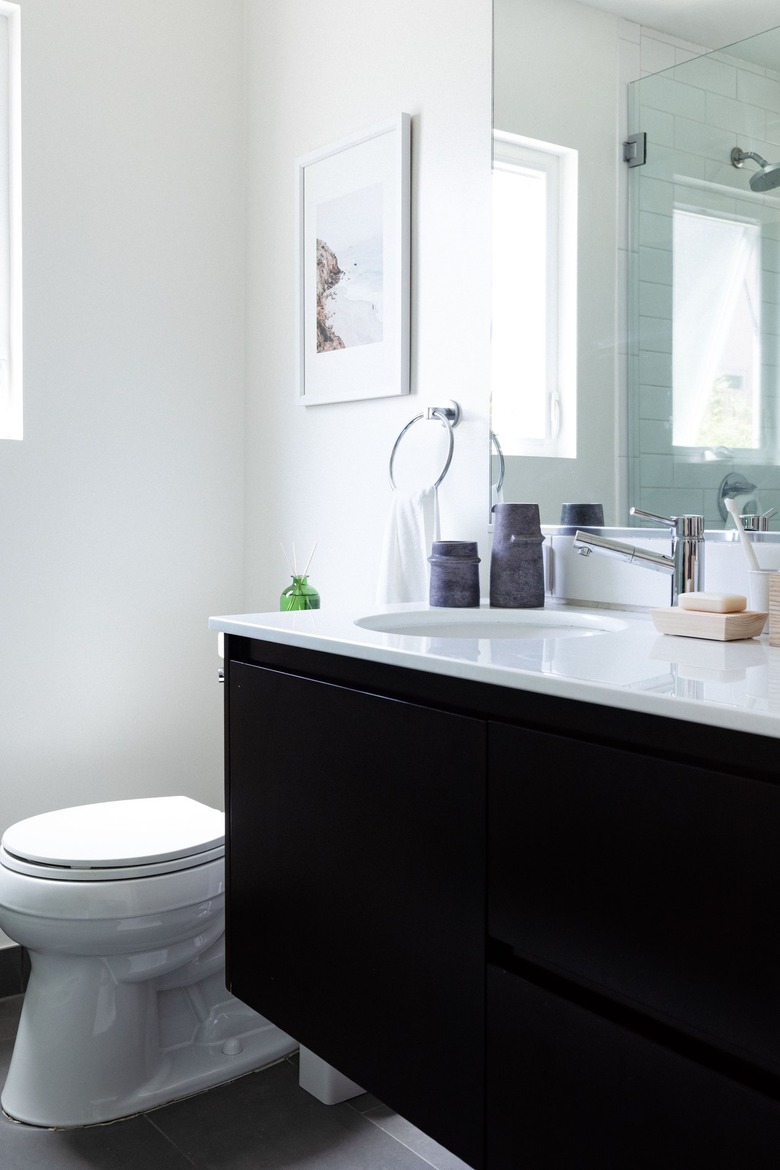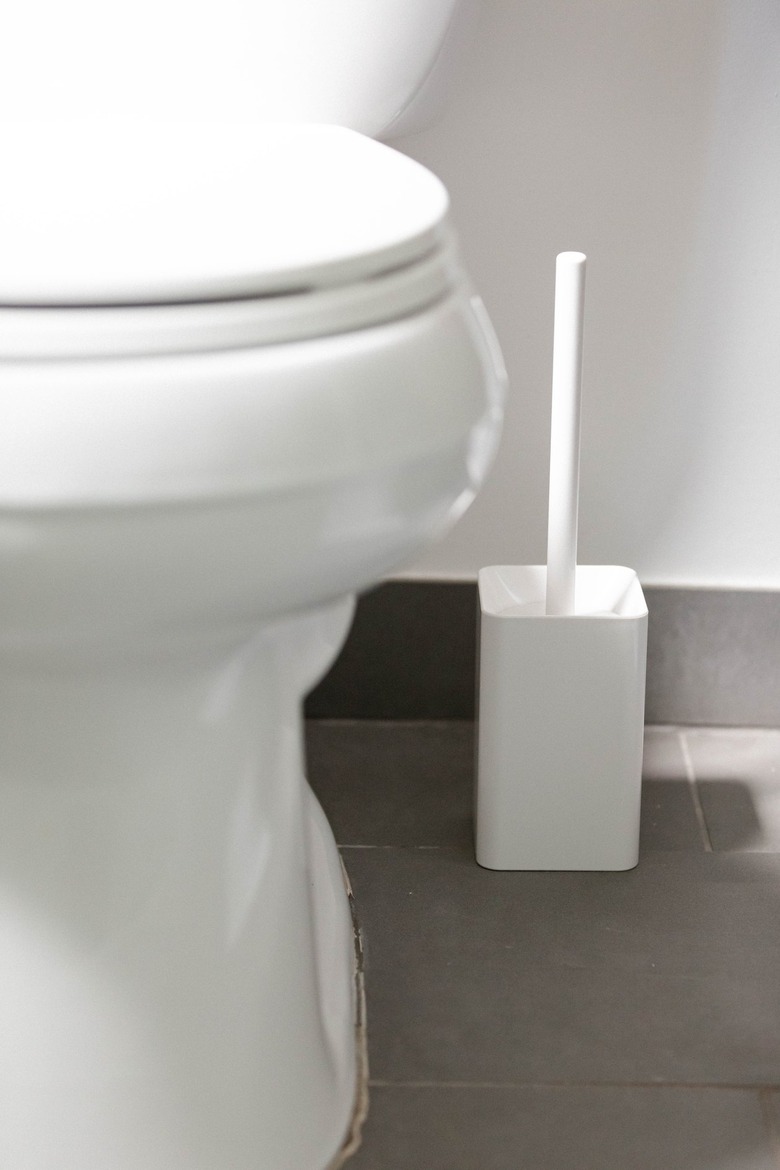Types Of Toilet Fill Valves
A toilet fill valve is that ever-so-important device that regulates when the water shuts off as the tank refills after a flush. While all such devices perform the same function, one toilet fill valve is not necessarily the same as the next. The best way to determine what type of fill valve is inside your toilet is to take off the tank lid and look inside. If the fill valve starts to fail, in most cases, you'll want to replace the valve with the same model, but if your fill valve is an older style, you may have to opt for a newer design.
Locating the Toilet Fill Valve
Locating the Toilet Fill Valve
The inner workings of the basic toilet tank contain two types of valves: the fill valve and the flush valve. The fill valve, sometimes referred to as a ballcock, is the assembly that sometimes has a floating cup or cylinder along its shaft. The cylinder rises and falls with the water level in the tank. For easy identification, the fill valve is the one that sits above the point where the water supply line connects to the toilet tank (since this is how the fill valve gets its water). An older and possibly more familiar style has a rod with a floating ball attached to the end instead of a device that floats up and down along the vertical valve assembly.
The flush valve is the device that has the flapper connected to it. This assembly releases water into the toilet bowl when the toilet is flushed. It usually sits closer to the center of the toilet; it's the valve that is not directly connected to a water source.
Ballcock, Rod and Ball Toilet Fill Valves
Ballcock, Rod and Ball Toilet Fill Valves
This vintage-style fill valve features the old-school rod and ball assembly. The ball or balloon shape on the end of the rod may even be made of metal. Like a float cup, it goes up and down with the water level. Once the ball reaches a certain height as the tank fills back up, it triggers the fill valve to stop adding water to the tank.
Although these are still manufactured, they're not as common as the float-cup-style fill valves that have largely replaced old ballcocks. Several versions of ballcocks exist. The oldest type has a brass vertical shaft with a water tube that fills the tank from near the bottom rather than depositing it into the overflow tube like newer models. These brass-bodied valves, often called piston or plunger ballcocks, feature a plunger or cup seal near the bottom to prevent leaks. These are still made by companies such as Prier.
A diaphragm-style ballcock may also have a brass vertical shaft, although many modern ones are made of plastic. Both types still feature the iconic rod and floating ball to control the water level. These do not have the plunger or piston to shut off water but instead contain a rubber diaphragm that flexes as water pressure changes in the tank. These may stretch out, requiring readjustment.
Float Cup Toilet Fill Valves
Float Cup Toilet Fill Valves
This type of toilet fill valve replaces the older ball and rod assembly. It fits many types of gravity-flush toilets, which are the standard floor-mounted type that have been around for generations. Some brands are designed to be universal for gravity-flush toilets, and many even have an adjustable height setting. On this type of toilet valve, a cylindrical plastic device moves up and down along the fill valve's vertical shank as the tank's water level changes. This plastic cylinder is called a float cup, although it doesn't always look like a cup.
When flushing the toilet, water rushes from the tank into the toilet bowl. As the tank's water level drops, the float cup also drops, signaling the fill valve to start refilling the tank. As the fill valve accesses water from the connected water line, this water travels up through the fill valve, sending water through a narrow flexible tube and into the overflow pipe of the flush valve to fill the toilet bowl.
At the same time, water flows from the bottom of the fill valve shaft to fill the tank. The water flow shuts off again once the water level and the float cup rise to the preselected shutoff point. This setting can be adjusted by squeezing a clip and moving the float cup up or down along the valve shaft.
Floatless, Pressure-Activated and Anti-Siphon Valves
Floatless, Pressure-Activated and Anti-Siphon Valves
Some toilet fill valves sense changes in water pressure rather than relying on floating parts to control the water level in the tank. These floatless or pressure-activated toilet valves often look similar to many fill valves for gravity-fed toilets except they're missing the cup or cylinder that moves along the valve's shaft. Other types have no shaft and sit very low in the bottom of the tank. If a floatless valve stops functioning properly, replacing it is likely a better option than attempting a repair. These should fit most gravity toilets, especially if the replacement part has the word "universal" on the packaging.
An anti-siphon valve prevents water from being sucked back into the water supply during times of low water pressure in the water system. Older styles of valves without anti-siphon properties would potentially allow water to be drawn out of the toilet tank and into the local water supply in the event of a water shutdown, which resulted in water supply contamination in some cases. Almost all of the valves currently sold have anti-siphon properties, and most, if not all, float cup fill valves have anti-siphon properties, as current regulations require this in most areas. And although it's probably a given, look for the term "anti-siphon" on the packaging when purchasing a replacement fill valve for your toilet.
Dual-Flush Fill Mechanics
Dual-Flush Fill Mechanics
A dual-flush toilet offers two types of flush: a "full flush" with a standard amount of water or a "half flush" that uses less water, typically used for liquid waste. These have two pushbuttons or a two-position lever for activating the flush. The flush valve assembly is completely different from that of a standard toilet, yet the fill valve is much like a standard toilet's fill valve. In some cases, it may even be the same model used on fairly new toilets without the dual-flush feature.
Companies such as Fluidmaster even sell conversion kits that allow you to transform almost any fairly current gravity-flush toilet to a dual-flush model. These kits always include a new flush valve fitting to allow the toilet two different flush options. Some also come with a fill valve, which may be the same fill valve sold as a universal toilet valve for most gravity toilets, even the single-flush variety.
As with other types of toilets, some dual-flush models may use proprietary products, including fill valves that don't fit other toilet brands or models. Check your toilet's owner manual for specific replacement suggestions for a faulty fill valve.
Pressure- and Vacuum-Assisted Toilets
Pressure- and Vacuum-Assisted Toilets
A pressure-assisted toilet works differently than a gravity toilet, so it does not use a traditional fill valve. Instead, the toilet tank contains another large, enclosed tank, designed to create pressure to aid in flushing. As you flush a pressure-assisted toilet, this special tank releases a burst of pressurized water, creating a powerful flush.
The inner workings of this type of toilet are so different from the typical gravity-fed toilet that it may seem confusing to troubleshoot issues. While some minor items can be adjusted, many problems require the purchase of replacement parts rather than repairing them.
A vacuum-assisted toilet's tank innards look like a hybrid of a gravity toilet and a pressure-assisted toilet. This type of toilet still uses standard gravity toilet fill and flush valves, but there's also a separate tank inside the toilet tank. As you flush the toilet, the water leaving the main tank creates suction in the inner tank, which is also connected to the channel exiting the toilet bowl. This added suction power helps create a more powerful flush than the average gravity toilet but not necessarily as powerful as the pressure-assisted toilet.
While this type of toilet isn't commonplace, it's easy to replace the fill and flush valves as needed since these are standard off-the-shelf items found in virtually any store with a plumbing aisle.
References
- Fluidmaster: Fill Valves
- Marion County, Florida: How to Fix a Leaky Toilet
- Tureks Plumbing Services: How to Adjust a Toilet Fill Valve
- PlumbingSupply.com: How to Replace a Fill Valve
- Fluidmaster: Solutions for Common Dual Flush Toilet Problems
- Fluidmaster: 550DFRK – Dual Flush Conversion System
- Plumbmaster: Prier 09 Series Ballcock
- Prier: Brass Ballcock
- City of Portland, Michigan: Water Level Adjustment

